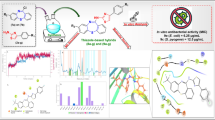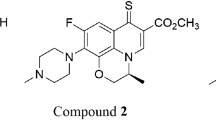Abstract
Two new water-soluble pip and hpip analogs, 1 and 2 pip = 2-phenylimidazo[4,5-f][1, 10]phenanthroline; hpip = 2-(2-hydroxyphenyl)imidazo[4,5-f][1, 10]phenanthroline, have been synthesized and fully characterized by CHN analysis, MALDI-TOF MS, 1H-NMR, IR (ATR), and UV–Vis methods. The DNA-binding behaviors of both compounds have been studied by viscosity measurements, spectroscopic methods, and gel electrophoresis studies, and potential for antitumor activity was evaluated by measuring their ability to inhibit DNA transcription. The results indicate that both compounds show some strong binding to DNA in a mixture of electrostatic and intercalative mode resulting in the intrinsic binding constants Kb of (4.0 ± 0.5) × 105 M−1 and (7.5 ± 0.5) × 105 M−1 for 1 and 2, respectively. These strong binding affinities for DNA are comparable for that seen for many transition metal-based intercalators. Comparatively, observed difference in the DNA-binding affinities of two complexes can be reasonably explained by the presence of an intra-molecular hydrogen-bonding between the ortho-phenolic group and the nitrogen atom of the imidazole ring. The extended co-planarity of 2 due to the intramolecular hydrogen bonding may lead to an enhancement of DNA binding affinity of 2. In addition, 2 can promote cleavage of pBR322 DNA upon irradiation, it inhibits DNA transcription and it is more cytotoxic at lower concentrations in comparison to 1, as revealed by the spectroscopic measurements.








Similar content being viewed by others
References
Kashanian, S., & Dolatabadi, J. E. N. (2009). DNA binding studies of 2-tert-butylhydroquinone (TBHQ) food additive. Food Chemistry, 116, 743–747.
Lerman, L. S. (1961). Structural considerations in the interaction of DNA and acridines. Journal of Molecular Biology, 3, 18–30.
Waring, M. J. (1972). The molecular basis of antibiotic action. New York: John Wiley and Sons.
Barton, J. K., Goldberg, J. M., Kumar, C. V., & Turro, N. J. (1986). Binding modes and base specificity of tris(phenanthroline)ruthenium(II) enantiomers with nucleic acids: tuning the stereoselectivity. Journal of the American Chemical Society, 108, 2081–2088.
Bhakta, D., Lulu, S., Jayaraman, G., Babu, S., & Siva, R. (2013). Interaction of plant pigment brazilin with synthetic and natural DNA: spectroscopic and in silico perspective. Interdisciplinary Sciences: Computational Life Sciences, 5, 53–59.
Bhakta, D., & Siva, R. (2012). Morindone, an anthraquinone, intercalates DNA sans toxicity: a spectroscopic and molecular modeling perspective. Applied Biochemistry and Biotechnology, 167, 885–896.
Cusumano, M., Di Pietro, M. L., & Giannetto, A. (2006). DNA interaction of platinum(II) complexes with 1,10-phenanthroline and extended phenanthrolines. Inorganic Chemistry, 45, 230–235.
Ghosh, P., Devi, G. P., Priya, R., Amrita, A., Sivaramakrishna, A., Babu, S., et al. (2013). Spectroscopic and in silico evaluation of interaction of dna with six anthraquinone derivatives. Applied Biochemistry and Biotechnology, 170, 1127–1137.
Xu, C.-J., & Li, B.-G. (2010). Synthesis and characterization of highly luminescent copolymers of methyl methacrylate and eu-complexed 5-Acryloxyethoxymethyl-8-hydroxyquinoline. Macromolecular Chemistry and Physics, 211, 1733–1740.
Novakova, O., Kasparkova, J., Vrana, O., van Vliet, P. M., Reedijk, J., & Brabec, V. (1995). Correlation between cytotoxicity and DNA binding of polypyridyl ruthenium complexes. Biochemistry, 34, 12369–12378.
Jamieson, E. R., & Lippard, S. J. (1999). Structure, recognition, and processing of cisplatin-DNA adducts. Chemical Reviews, 99, 2467–2498.
Erkkila, K. E., Odom, D. T., & Barton, J. K. (1999). Recognition and reaction of metallointercalators with DNA. Chemical Reviews, 99, 2777–2796.
Kelley, S. O., Holmlin, R. E., Stemp, E. D. A., & Barton, J. K. (1997). Photoinduced electron transfer in ethidium-modified dna duplexes: dependence on distance and base stacking. Journal of the American Chemical Society, 119, 9861–9870.
Farrell, N. (2002). Biomedical uses and applications of inorganic chemistry. An overview. Coordination Chemistry Reviews, 232, 1–4.
Chen, Y.-M., Liu, Y.-J., Li, Q., & Wang, K.-Z. (2009). pH- and DNA-induced dual molecular light switches based on a novel ruthenium(II) complex. Journal of Inorganic Biochemistry, 103, 1395–1404.
Coban, B., Yildiz, U., & Sengul, A. (2013). Synthesis, characterization, and DNA binding of complexes [Pt(bpy)(pip)]2+ and [Pt(bpy)(hpip)]2+. Journal of Biological Inorganic Chemistry, 18, 461–471.
Uma Maheswari, P., & Palaniandavar, M. (2004). DNA binding and cleavage properties of certain tetrammine ruthenium(II) complexes of modified 1,10-phenanthrolines—effect of hydrogen-bonding on DNA-binding affinity. Journal of Inorganic Biochemistry, 98, 219–230.
Zhang, Q.-L., Liu, J.-G., Liu, J., Xue, G.-Q., Li, H., Liu, J.-Z., et al. (2001). DNA-binding and photocleavage studies of cobalt(III) mixed-polypyridyl complexes containing 2-(2-chloro-5-nitrophenyl)imidazo [4,5-f][1, 10]phenanthroline. Journal of Inorganic Biochemistry, 85, 291–296.
Elmes, R. B. P., Erby, M., Cloonan, S. M., Quinn, S. J., Williams, D. C., & Gunnlaugsson, T. (2011). Quaternarized pdppz: synthesis, DNA-binding and biological studies of a novel dppz derivative that causes cellular death upon light irradiation. Chemical Communications, 47, 686–688.
Phillips, T., Haq, I., Meijer, A. J. H. M., Adams, H., Soutar, I., Swanson, L., et al. (2004). DNA binding of an organic dppz-based intercalator. Biochemistry, 43, 13657–13665.
Phillips, T., Rajput, C., Twyman, L., Haq, I., & Thomas, J. A. (2005). Water-soluble organic dppz analogues-tuning DNA binding affinities, luminescence, and photo-redox properties. Chemical Communications, 4327–4329.
Liu, Y.-J., Liang, Z.-H., Li, Z.-Z., Yao, J.-H., & Huang, H.-L. (2011). Cellular uptake, cytotoxicity, apoptosis, antioxidant activity and DNA binding of polypyridyl ruthenium(II) complexes. Journal of Organometallic Chemistry, 696, 2728–2735.
Yamada, M., Tanaka, Y., Yoshimato, S., Kuroda, S., & Shimao, I. (1992). Synthesis and properties of diamino-substituted dipyrido [3,2-A: 2',3'-c]phenazine. Bulletin of the Chemical Society of Japan, 65, 1006–1011.
Cohen, G., & Eisenberg, H. (1969). Viscosity and sedimentation study of sonicated DNA–proflavine complexes. Biopolymers, 8, 45–55.
Fu, P. K. L., Bradley, P. M., & Turro, C. (2003). Stabilization of duplex DNA structure and suppression of transcription in vitro by bis(quinone diimine) complexes of rhodium(III) and ruthenium(II). Inorganic Chemistry, 42, 878–884.
Fu, P. K. L., & Turro, C. (2001). Transcription inhibition by Rh(phi)(2)(phen)(3+). Chemical Communications, 279–280.
Steck, E. A., & Day, A. R. (1943). Reactions of phenanthraquinone and retenequinone with aldehydes and ammonium acetate in acetic acid solution1. Journal of the American Chemical Society, 65, 452–456.
Wu, J.-Z., Li, L., Zeng, T.-X., Ji, L.-N., Zhou, J.-Y., Luo, T., et al. (1997). Synthesis, characterization and luminiscent DNA-binding study of a series of ruthenium complexes containing 2-arylimidazo[f]1,10-phenanthroline. Polyhedron, 16, 103–107.
Liu, J.-G., Ye, B.-H., Li, H., Zhen, Q.-X., Ji, L.-N., & Fu, Y.-H. (1999). Polypyridyl ruthenium(II) complexes containing intramolecular hydrogen-bond ligand: syntheses, characterization, and DNA-binding properties. Journal of Inorganic Biochemistry, 76, 265–271.
Wu, J.-Z., Ye, B.-H., Wang, L., Ji, L.-N., Zhou, J.-Y., Li, R.-H. & Zhou, Z.-Y. (1997). Bis(2,2[prime or minute]-bipyridine)ruthenium(II) complexes with imidazo[4,5-f][1, 10]-phenanthroline or 2-phenylimidazo[4,5-f][1, 10]phenanthroline. Journal of the Chemical Society, Dalton Transactions, 1395–1402.
Barton, J. K., & Raphael, A. L. (1984). Photoactivated stereospecific cleavage of double-helical DNA by cobalt(III) complexes. Journal of The American Chemical Society, 106, 2466–2468.
Liu, J., Mei, W. J., Lin, L. J., Zheng, K. C., Chao, H., Yun, F. C., et al. (2004). Electronic effects on the interactions of complexes Ru(phen)(2)(p-L) (2+) (L = MOPIP, HPIP, and NPIP) with DNA. Inorganica Chimica Acta, 357, 285–293.
Zhang, Q.-L., Liu, J.-G., Liu, J.-Z., Li, H., Yang, Y., Xu, H., et al. (2002). Effect of intramolecular hydrogen-bond on the DNA-binding and photocleavage properties of polypyridyl cobalt(III) complexes. Inorganica Chimica Acta, 339, 34–40.
Zhang, Q.-L., Xu, H., Li, H., Liu, J., Liu, J.-Z., Ji, L.-N., et al. (2002). Synthesis, DNA-binding and photocleavage studies of cobalt(III) mixed-ligand complexes. Transit. Metal Chem., 27, 149–154.
Mudasir, Wijaya, K., Yoshioka, N., & Inoue, H. (2003). DNA binding of iron(II) complexes with 1,10-phenanthroline and 4,7-diphenyl-1,10-phenanthroline: salt effect, ligand substituent effect, base pair specificity and binding strength. Journal of Inorganic Biochemistry, 94, 263–271.
Chen, L.-M., Liu, J., Chen, J.-C., Tan, C.-P., Shi, S., Zheng, K.-C., et al. (2008). Synthesis, characterization, DNA-binding and spectral properties of complexes [Ru(L)4(dppz)]2+ (L = Im and MeIm). Journal of Inorganic Biochemistry, 102, 330–341.
Satyanarayana, S., Dabrowiak, J. C., & Chaires, J. B. (1993). Tris(phenanthroline)ruthenium(II) enantiomer interactions with DNA: Mode and specificity of binding. Biochemistry, 32, 2573–2584.
Satyanarayana, S., Dabrowiak, J. C., & Chaires, J. B. (1992). Neither .DELTA.- nor .LAMBDA.-tris(phenanthroline)ruthenium(II) binds to DNA by classical intercalation. Biochemistry, 31, 9319–9324.
Shi, C.-Y., Gao, E.-J., Ma, S., Wang, M.-L., & Liu, Q.-T. (2010). Synthesis, crystal structure, DNA-binding and cytotoxicity in vitro of novel cis-Pt(II) and trans-Pd(II) pyridine carboxamide complexes. Bioorganic & Medicinal Chemistry Letters, 20, 7250–7254.
Talib, J., Harman, D. G., Dillon, C. T., Aldrich-Wright, J., Beck, J. L. & Ralph, S. F. (2009). Does the metal influence non-covalent binding of complexes to DNA? Dalton Transactions, 504–513.
Wang, X.-L., Chao, H., Li, H., Hong, X.-L., Liu, Y.-J., Tan, L.-F., et al. (2004). DNA interactions of cobalt(III) mixed-polypyridyl complexes containing asymmetric ligands. Journal of Inorganic Biochemistry, 98, 1143–1150.
Portugal, J., Martin, B., Vaquero, A., Ferrer, N., Villamarin, S., & Priebe, W. (2001). Analysis of the effects of daunorubicin and WP631 on transcription. Current Medicinal Chemistry, 8, 1–8.
Stellrecht, C. M., & Chen, L. S. (2011). Transcription inhibition as a therapeutic target for cancer. Cancers, 3, 4170–4190.
Takusagawa, F., Carlson, R. G., & Weaver, R. F. (2001). Anti-leukemia selectivity in actinomycin analogues. Bioorganic & Medicinal Chemistry, 9, 719–725.
Yan, C., & Higgins, P. J. (2013). Drugging the undruggable: transcription therapy for cancer. Biochimica et Biophysica Acta (BBA) - Reviews on Cancer, 1835, 76–85.
Acknowledgments
The authors are grateful to the supports of Bulent Ecevit University for grant 2011-03-13-06. The authors also thank to Assoc. Prof. Stephen Ralph at the Wollongong University for his support and Dr. Zehra Safi Oz for the use of her laboratory to make it possible to visualize and photograph the gel electrophoresis results.
Author information
Authors and Affiliations
Corresponding author
Electronic supplementary material
Below is the link to the electronic supplementary material.
ESM 1
(PDF 305 kb)
Rights and permissions
About this article
Cite this article
Coban, B., Yildiz, U. DNA-Binding Studies and Antitumor Evaluation of Novel Water Soluble Organic pip and hpip Analogs. Appl Biochem Biotechnol 172, 248–262 (2014). https://doi.org/10.1007/s12010-013-0513-7
Received:
Accepted:
Published:
Issue Date:
DOI: https://doi.org/10.1007/s12010-013-0513-7




